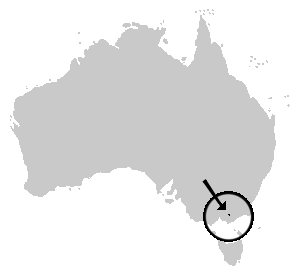Baw Baw frog facts for kids
Quick facts for kids Baw Baw frog |
|
|---|---|
 |
|
| Conservation status | |
| Scientific classification | |
 |
|
| Range of the Baw Baw Frog |
The Baw Baw frog (Philoria frosti) is a special kind of frog found only in Australia. It is a critically endangered species, which means it's very close to disappearing forever.
The main reason for its population drop is a sickness caused by a type of fungus called chytrid fungus. To help save these frogs, Zoos Victoria started a special breeding program in 2010. They even managed to get the first eggs laid in captivity in 2018!
Contents
Discovering the Baw Baw Frog
This frog was first described in 1901 by a scientist named Walter Baldwin Spencer. He named it Philoria frosti to honor Charles Frost. Charles Frost was an Australian naturalist who helped Spencer find the first frogs.
Frost found five of these frogs after they had been eaten and then brought up by a tiger snake. This unusual discovery helped scientists learn about this new species.
What Does the Baw Baw Frog Look Like?
Adult Baw Baw frogs are usually between 42 and 55 millimeters long. That's about the size of a small matchbox! They have a dark brown color. Their bellies are often brown to dark brown with yellow spots.
These frogs have a noticeable parotoid gland behind each eye. This gland can release a milky substance when the frog feels threatened. Their toes are not webbed, which is different from many other frogs.
When they first hatch, the tadpoles are creamy white. They don't have much color yet. As they grow, they get more color and their eyes become pigmented. Tadpoles have large yolk sacs, which provide them with food. They don't need to eat until they change into frogs. Young frogs, called metamorphlings, look a bit different from the adult frogs.
Why Are Baw Baw Frogs Disappearing?
The number of Baw Baw frogs has dropped a lot over the years. In 1983, there were an estimated 15,000 to 10,000 male frogs. Now, some estimates say there are fewer than 250 individuals left.
Scientists believe the main reason for this decline is a disease called chytridiomycosis. This disease is caused by the chytrid fungus. This fungus is very dangerous for amphibians like frogs. It can cause frog populations to drop quickly, even in healthy environments.
Helping the Baw Baw Frog Survive
To stop the Baw Baw frog from going extinct, a special breeding program was started. Zoos Victoria is leading this important effort. When the program began in 2010, scientists didn't know much about how to care for these frogs in captivity.
They built a special artificial environment for the frogs inside a shipping container. They even called it "the Baw Baw Bunker"! In 2011, they collected the first eggs from the wild, but they didn't hatch.
Things improved in 2013, when 96 young frogs were successfully raised from collected eggs. In 2016, eleven female frogs were brought in from the wild for the first time. Then, on October 22, 2018, the first eggs were laid in captivity! Researchers planned to release these eggs into a fungus-free area on Mt Baw Baw.
In November 2020, about 1,000 Baw Baw frogs were thought to be left in the wild. That year, 25 male and 25 female adult frogs were released onto Mt Baw Baw. These frogs had tiny radio transmitters on their backs. Scientists hope that releasing adult frogs will help create a stronger population faster than just releasing eggs.
See also
 In Spanish: Philoria frosti para niños
In Spanish: Philoria frosti para niños


